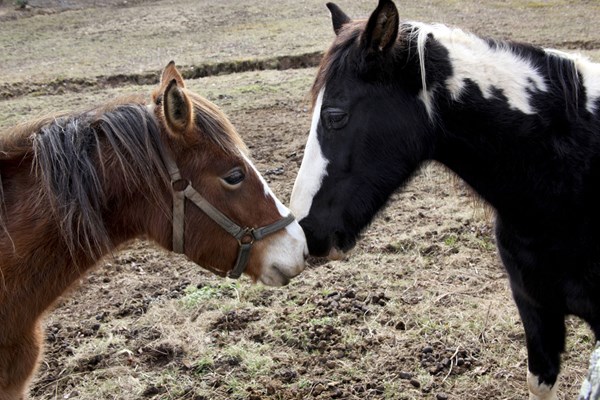There are two ways to protect a horse from influenza—vaccination and biosecurity. “Vaccination is helpful, but it simply protects the horse for a short period of time,” said Dr. Mark Crisman, senior veterinarian, Equine Technical Services at Zoetis.
 Credit: Thinkstock The influenza virus is spread most readily with nose-to-nose contact.
Credit: Thinkstock The influenza virus is spread most readily with nose-to-nose contact.“I can’t emphasize enough the importance of biosecurity,” he said. This means keeping new arrivals at the farm or stable separate from the main herd for two weeks, quarantine of sick horses, etc.
“But this is the hardest thing to get people to do,” Crisman continued. “New horses need to be isolated, checked closely and monitored to make sure they are staying healthy, with temperatures taken twice daily.” The biggest problem is that some farms and most boarding stables don’t have a facility to keep incoming horses separate.
“Disinfection of equipment is important if we have a sick horse to make sure we aren’t spreading the virus to other horses on shared tools and other equipment,” said Crisman. “Some people use bleach solutions, but organic matter like straw and manure makes bleach ineffective. Fortunately the influenza virus is not very hardy out in the environment. If it is sitting on a bare surfac,e it won’t last very long (a few hours, or occasionally a few days), to be picked up by another horse. It is primarily spread by nasal secretions from one horse to the mucus membrane of the second horse. t’s not like strangles, which can survive in the environment or in water buckets a lot longer.”
The influenza virus is spread most readily with nose-to-nose contact and generally doesn’t live more than a few hours outside the horse, but it can be transmitted on objects that are used on or touched by other horses. Don’t share grooming tools/cloths/water buckets or other equipment among horses.
“Some biosecurity procedures can be very simple, such as washing your hands,” said Crisman. “The thing to remember about viruses, especially influenza, is that it transmits very easily from horse to horse and it does not have to be direct nose-to-nose contact. Horse owners need to be aware of how easy it is to spread the virus from a sick horse to another horse nearby.”
It is easy to transmit this disease, yet it’s also easy to kill the influenza virus if you take steps to disinfect things between horses. Soap and water will kill this virus, as will laundry detergent, bleach, Lysol, etc. It generally doesn’t last long in the environment, but it can last longer than people originally thought. Research has shown that in some circumstances (shielded from heat and direct sunlight), it might last a few weeks. If a sick horse was coughing into hay or bedding, then another horse came along the next day or so and nosed around in that same hay or bedding, there might be some risk of transmission.


